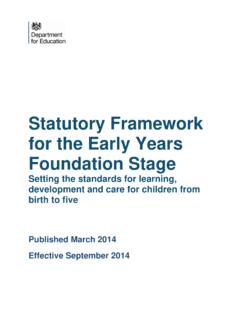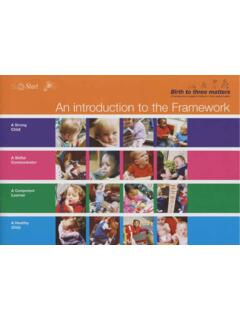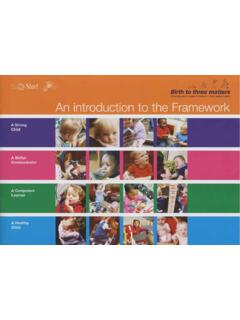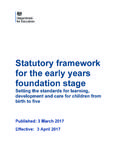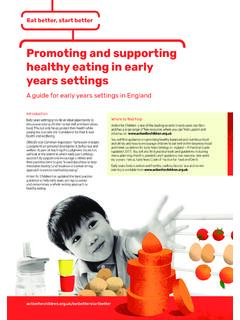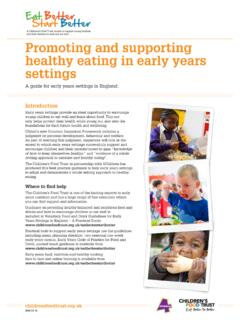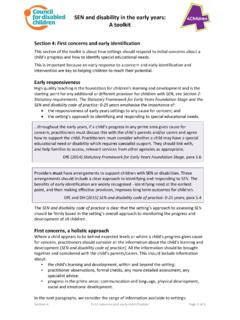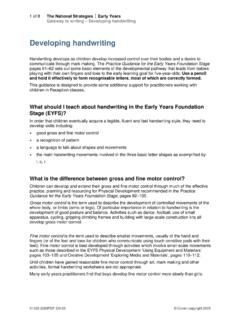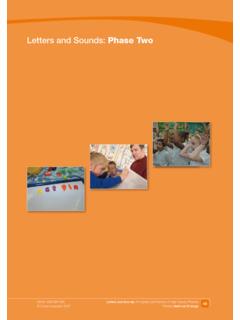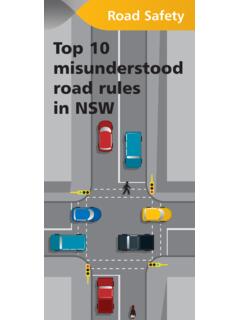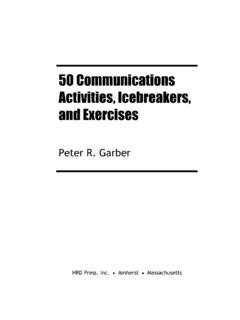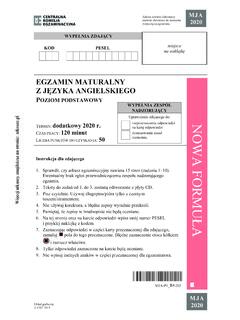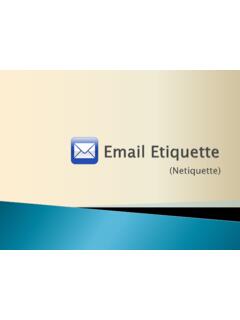Transcription of Letters and Sounds: Phase Six - Foundation Years
1 Letters and Sounds: Phase Six 00281-2007 BKT-EN Letters and Sounds: Principles and Practice of High Quality Phonics 166. Crown copyright 2007 Primary National Strategy Phase Six (throughout Year 2). Letters and Sounds: Phase Six Contents Page Summary 168. Reading 168. Spelling 170. Teaching spelling 170. Introducing and teaching the past tense Investigating and learning how to add suffixes Teaching spelling long words Finding and learning the difficult bits in words Learning and practising spellings 179. Application of spelling in writing 183. Marking Children gaining independence Knowledge of the spelling system 187. Some useful spelling guidelines Adding suffixes to words Practice examples 191. Key This icon indicates that the activity can be viewed on the DVD. Letters and Sounds: Principles and Practice of High Quality Phonics 00281-2007 BKT-EN.
2 167 Primary National Strategy Crown copyright 2007. Summary By the beginning of Phase Six, children should know most of the common grapheme . phoneme correspondences (GPCs). They should be able to read hundreds of words, Letters and Sounds: Phase Six doing this in three ways: reading the words automatically if they are very familiar;. decoding them quickly and silently because their sounding and blending routine is now well established;. decoding them aloud. Children's spelling should be phonemically accurate, although it may still be a little unconventional at times. Spelling usually lags behind reading, as it is harder. (See Appendix 3: Assessment.). During this Phase , children become fluent readers and increasingly accurate spellers. READING. At this stage many children will be reading longer and less familiar texts independently and with increasing fluency.
3 The shift from learning to read to reading to learn takes place and children read for information and for pleasure. Children need to learn some of the rarer GPCs (see Notes of Guidance for Practitioners and Teachers, Appendix 2, page 19,) and be able to use them accurately in their reading. A few children may be less fluent and confident, often because their recognition of graphemes consisting of two or more Letters is not automatic enough. Such children may still try to use phonics by sounding out each letter individually and then attempting to blend these sounds (for instance /c/-/h/-/a/-/r/-/g/-/e/ instead of /ch/-/ar/-/ge/). This is all too often misunderstood by teachers as an overuse of phonics rather than misuse, and results in teachers suggesting to children that they use alternative strategies to read unfamiliar words. Instead the solution is greater familiarity with graphemes of two or more Letters .
4 The necessity for complete familiarity with these graphemes cannot be overstated. The work on spelling, which continues throughout this Phase and beyond, will help children to understand more about the structure of words and consolidate their knowledge of GPCs. For example, children who are not yet reliably recognising digraphs and are still reading them as individual Letters will get extra reinforcement when they learn to spell words containing the digraphs such as road, leaf, town, cloud, shop. As children find that they can decode words quickly and independently, they will read more and more so that the number of words they can read automatically builds up. There is a list of the 300 high-frequency words in Appendix 1 on pages 193 195. Increasing the pace of reading is an important objective. Children should be encouraged to read aloud as well as silently for themselves.
5 00281-2007 BKT-EN Letters and Sounds: Principles and Practice of High Quality Phonics 168. Crown copyright 2007 Primary National Strategy Knowing where to place the stress in polysyllabic words can be problematic. If the child has achieved a phonemic approximation of the word, particularly by giving all vowels their full value, the context of the sentence will often provide a sensible resolution; the child should then recheck this against the Letters . Working through the word in this way will Letters and Sounds: Phase Six make it easier for it to be read more automatically in future. In Phase Six, many children will be able to read texts of several hundred words fluently at their first attempt. Those children who are less fluent may benefit from rereading shorter texts several times, not in order to memorise the texts, but to become more familiar with at least some of the words that cause them to stumble, and to begin to experience what fluent reading feels like.
6 To become successful readers, children must understand what they read. They need to learn a range of comprehension strategies and should be encouraged to reflect upon their own understanding and learning. Such an approach, which starts at the earliest stages, gathers momentum as children develop their fluency. Children need to be taught to go beyond literal interpretation and recall, to explore the greater complexities of texts through inference and deduction. Over time they need to develop self-regulated comprehension strategies: activating prior knowledge;. clarifying meanings with a focus on vocabulary work;. generating questions, interrogating the text;. constructing mental images during reading;. summarising. Many of the texts children read at this stage will be story books, through which they will be developing an understanding of the author's ideas, plot development and characterisation.
7 It is important that children are also provided with opportunities to read a range of non-fiction texts, which require a different set of strategies. The use of a contents page, index and glossary makes additional demands on young readers as they search for relevant information. In reading simple poems, children need to adapt to and explore the effects of poetic language, continuing to develop their understanding of rhythm, rhyme and alliteration. From an early stage, children need to be encouraged to read with phrasing and fluency, and to take account of punctuation to aid meaning. Much of the reading now will be silent and children will be gaining reading stamina as they attempt longer texts. In addition, as children read with growing independence, they will engage with and respond to texts; they will choose and justify their choice of texts and will begin to critically evaluate them.
8 It is important throughout that children continue to have opportunities to listen to experienced readers reading aloud and that they develop a love of reading. Letters and Sounds: Principles and Practice of High Quality Phonics 00281-2007 BKT-EN. 169 Primary National Strategy Crown copyright 2007. SPELLING. Teaching spelling Letters and Sounds: Phase Six Introducing and teaching the past tense The past tense dealt with in this section is simple past tense, I looked, not continuous past tense, I was looking. Before you teach children to spell the past tense forms of verbs, it is important that they gain an understanding of the meaning of tense'. Since many common verbs have irregular past tenses ( go went, come came, say said) it is often easier to teach the concept of past tense separately from the spelling of past tense forms. Short oral games can be used for this purpose.
9 For example, a puppet could say Today I am eating an egg what did I eat yesterday? The response could be Yesterday you ate a sandwich, Yesterday you ate some jam. The puppet could say Today I am jumping on the bed. Where did I. jump yesterday? and the response could be Yesterday you jumped in the water, etc. These games can be fitted into odd moments now and then; several children could respond in turn, and the games would also serve as memory training (don't repeat what's already been suggested). Using familiar texts Procedure Use a current class text as the basis for discussion about tense. 1. Find extracts of past tense narrative and ask children to describe what is happening in the present tense. For example, use extracts from Funnybones (by Alan Alhberg and Janet Alhberg, published by Puffin Books) such as where the skeletons leave the cellar, climb the stairs and walk to the park.
10 2. Let the children compare the two versions. Discuss how they are different both in meaning and language. 3. Use the words yesterday and today to reinforce the different meanings. 4. Find bits of present tense dialogue in the text and ask children to retell it as past tense narrative. 00281-2007 BKT-EN Letters and Sounds: Principles and Practice of High Quality Phonics 170. Crown copyright 2007 Primary National Strategy Investigating and learning how to add suffixes Letters and Sounds: Phase Six Phoneme frame Purpose To reinforce understanding and application of the -ed suffix for the past tense Prerequisite The children must have an understanding of the grammar of the past tense and experience of segmenting words into phonemes Resources For whole-class work Set of five-box and six-box phoneme frames drawn on the whiteboard Set of five-box and six-box phoneme frames, on laminated card so they can be reused, one per pair of children Word cards placed in a bag ( rounded, helped, turned, begged, hissed, wanted, sorted, hummed, waded, washed, hated, greased, lived, robbed, rocked, laughed, called, roasted).
